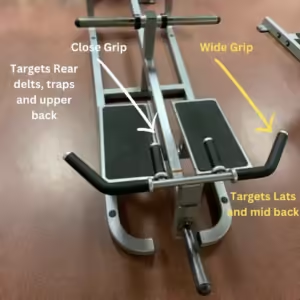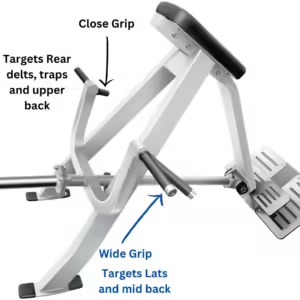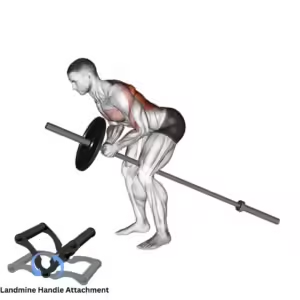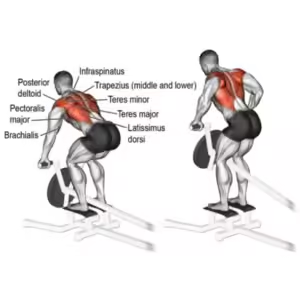The T-bar row is a highly effective exercise that targets the upper body, particularly the back muscles. Renowned for its ability to build strength and enhance muscle mass, this compound movement engages key muscle groups, including the lats, rhomboids, and trapezius. It’s a favorite among strength training enthusiasts and athletes due to its versatility and effectiveness in improving posture and overall back strength. In this blog post, we’ll explore the benefits of the T-bar row, how to perform it correctly, and tips for incorporating it into your workout routine. Get ready to elevate your strength training game!
T Bar Row
The T-bar row is a compound exercise that utilizes a specialized machine or weight setup to target specific muscles in your back. The setup consists of a bar anchored at one end to a stabilizing tool or wall. When an attachment is placed under the bar, it creates a “T” shape at the opposite end, where you can stack weight plates. This design allows the bar to move like free weights while providing the stability of machine equipment. By performing this exercise, you can enhance strength, stability, and overall muscle growth in your upper body, including your arms, forearms, and trapezius. One of the main reasons I appreciate this exercise is its ability to ensure stability throughout the movement. Going further I will briefly discuss different variations of T Bar row
T Bar Row Machine

The T bar row machine is a specialized piece of gym equipment designed to target the upper and middle back. By keeping the weight fixed on a pivot, this machine reduces the need for balance, allowing users to focus on proper form and muscle engagement. Beginners and experienced lifters alike benefit from the machine’s stability, which supports developing a consistent movement pattern.
Tips for Using the T Bar Row Machine
- Start with a weight you can handle without sacrificing form.
- Grip the handles firmly and keep your back straight.
- Use your back to pull, engaging your lats and rhomboids while keeping your elbows close to your sides.
Wide Grip
- How to Perform: Use a wider grip on the handle. This variation emphasizes the upper back and rear deltoids.
- Benefits: Engages the upper lats and improves shoulder stability.
Close Grip
- How to Perform: Use a narrow grip on the handle. This variation focuses more on the lower lats and mid-back.
- Benefits: Enhances strength in the lower back and helps with muscle definition.
Chest Supported T Bar Row

The chest-supported T bar row is a variation where padded support rests against your chest, helping you maintain stability and preventing the lower back from overworking. This variation is especially useful for lifters looking to isolate the upper back and reduce strain on the lower spine.
Benefits of Chest-Supported T-Bar Rows
- Helps maintain proper alignment by reducing lower back involvement.
- Reduces the risk of injury.
- Allows for more controlled, focused lifting with better muscle isolation.
Wide Grip
- How to Perform: Use a wider grip on the handle. This variation emphasizes the upper back and rear deltoids.
- Benefits: Engages the upper lats and improves shoulder stability.
Close Grip
- How to Perform: Use a narrow grip on the handle. This variation focuses more on the lower lats and mid-back.
- Benefits: Enhances strength in the lower back and helps with muscle definition.
Barbell T Bar Row

The Barbell T-Bar Row is a powerful exercise that targets the upper back, lats, and overall upper body strength. This exercise can be performed using a barbell with bare hands or a landmine attachment. Here’s a closer look at the Barbell and its landmine variation:
Barbell T-Bar Row
Setup and Execution:
- Equipment Needed: A barbell, weight plates, and a place to anchor the barbell.
- Positioning: Stand over the barbell with your feet shoulder-width apart. Bend your knees slightly and hinge at the hips, keeping your back straight.
- Grip: Grip the handle or the bar with both hands, positioning them shoulder-width apart or wider, depending on your preference.
- Rowing Motion: Pull the bar towards your torso while squeezing your shoulder blades together. Keep your elbows close to your body.
- Return: Slowly lower the bar back to the starting position, maintaining control throughout the movement.
Benefits:
- Builds strength in the upper back, lats, and arms.
- Enhances posture and stability.
- Engages multiple muscle groups for overall upper body development.
Landmine T-Bar Row Variation
The Landmine variation utilizes a barbell anchored in a landmine attachment, offering a unique way to perform the T-bar row.
Setup and Execution:
- Equipment Needed: A barbell and a landmine attachment or a corner of a wall.
- Positioning: Place one end of the barbell into the landmine attachment. Load the opposite end with weight plates.
- Grip: Stand facing the bar, with your feet shoulder-width apart. Bend at the hips and grip the bar with both hands, keeping your back straight and core engaged.
- Rowing Motion: Pull the bar towards your chest, focusing on squeezing your shoulder blades together. Keep your elbows close to your sides.
- Return: Lower the bar back to the starting position in a controlled manner.
Benefits of the Landmine Variation:
- Provides a fixed pivot point, enhancing stability and control during the movement.
- Allows for a greater range of motion, targeting the back muscles more effectively.
- Reduces strain on the lower back, making it suitable for individuals with back concerns.
- Offers versatility in grip and stance, allowing for customization based on individual comfort and goals.
T Bar Row Alternatives
For those looking to change up their routine, several alternatives can achieve similar benefits:
- Bent-Over Barbell/Dumbbell Rows: This exercise requires balancing with a barbell or dumbbell in both hands and engages the entire back.
- Seated Cable Chest supported/without chest support Rows: Great for targeting the middle back with a supported position.
- Single-Arm Dumbbell Rows: Focuses on the lat muscles individually for better muscle balance.
- Pendlay Row: focuses on building explosive strength and power in the back, particularly the lats, traps, and upper back.
When to Use Alternatives
Alternatives are helpful if you don’t have access to a T bar machine or want to add variety. Try incorporating these options to ensure balanced muscle development and to prevent adaptation.
T Bar Row vs. Barbell Row
While both exercises target the back, the T bar row offers more stability, making it ideal for beginners and those with lower back sensitivity. The barbell row, on the other hand, requires greater core stability and balance, challenging additional muscle groups.
| Exercise | Stability | Core Engagement | Ideal For |
|---|---|---|---|
| T Bar Row | High | Moderate | Beginners, muscle isolation |
| Barbell Row | Low | High | Advanced lifters, overall strength |
T Bar Row Muscles Worked

The T bar row is a compound exercise that engages multiple muscle groups, including:
- Primary Muscles: Latissimus dorsi, rhomboids, trapezius, and biceps.
- Secondary Muscles: Rear deltoids and erector spinae.
Developing these muscles leads to a stronger, broader back, improving both appearance and functional strength. A strong back supports good posture and can enhance performance in other exercises.
Conclusion
The row performed with a T-bar is a versatile and effective exercise for building a strong, muscular back. Whether you’re new to strength training or a seasoned lifter, integrating T bar rows can improve your upper body strength, enhance muscle growth, and support a well-rounded workout routine.
FAQ
- What is the T bar row good for?
It builds back muscles, improves posture, and strengthens the upper body. - Can beginners do T bar rows?
Yes, this row is beginner-friendly, especially with the machine. - What’s the difference between T-bar row and barbell row?
The T-bar row offers more stability, while the barbell row requires balance and core engagement. - How much weight should I use for T bar rows?
Start light to focus on form, gradually increasing as you build strength. - What muscles do T bar rows work?
Primarily the lats, rhomboids, traps, and biceps. - Are chest-supported rows better for the back?
They reduce lower back strain and isolate upper back muscles. - How often can I do T bar rows?
Twice a week, with 48 hours between sessions for muscle recovery. - Can I do T bar rows without a machine?
Yes, try bent-over rows or other rowing alternatives if a machine isn’t available. - Do T bar rows help with posture?
Yes, they strengthen the upper back, supporting better posture. - Should I add T bar rows to my routine?
If you’re looking to build back strength and size, T bar rows are a great addition.
Thank you for reading, for more interesting articles visit our homepage.



